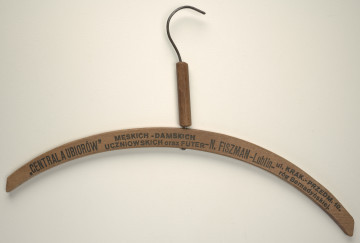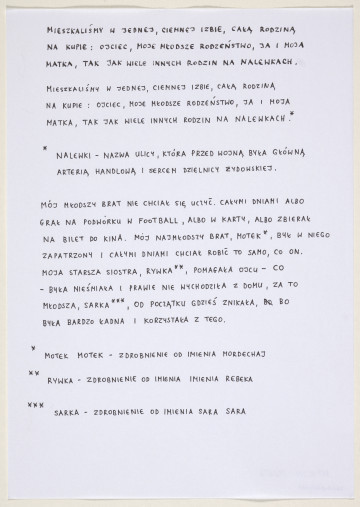
Clothes hanger
non post 1939
Museum of the history of Polish Jews
A representation of the Jewish family of a shoemaker Rotfarb and his work. On the board, Olga Wróbel placed frames in two rows, separated by a white strip - a window for the narrative text; in the published comic book we read here (in the album - text in capital letters, see lettering cards, MPOLIN-M268 in particular): “My younger brother did not want to study. All day he would either play football in the yard or cards or collect for a ticket to cinema. My youngest brother, Motek *, looked up to him and wanted to do what he did all day. My older sister, Rywka, helped my father - she was shy and hardly left the house, but the youngest, Sarka **, spent all days in the yard with the boys”. At the bottom of the frame, in smaller letters, an explanations of the two names: *Motek - diminutive of the name Mordechaj ** Sarka - diminutive of the name Sara.
In the top row of the board both frames show siblings with balls. In the lower one, the father at a sewing machine and, as we can guess, Rywka, referred to in the narrative. Olga Wróbel uses details of a ribbon to reflect her relationship with her father's work: the ribbon with which her hair is tied rises upwards, becoming within the composition a mirror image of the shoelace from the shoe prepared by the shoemaker, which shown in a small frame above the frame with the portrait of the girl.
The Rotfarb family lived at Nalewki Street, a street that owned its development to Jewish settlers, and with time became a symbol of Jewish presence in Warsaw. At Nalewki Street, the tenement houses were multi-storey and - due to the elongated shapes of the squares - also multi-yard. “The yard was always bustling and lively […]. I immediately took interest in the life of the yard - recalled Abraham Rotfarb in his text, although this was not emphasized by Powalisz in the comic book narrative, which focused on the later stage of Rotfarb’s interests not in the backyard, but in education.
As it was probably the case of the Rotfarb house, the apartments were at the same time workshops or shops.
According to the census from the beginning of the 20th century, there were over 300 points of sale at Nalewki Street.
Author / creator
Dimensions
cały obiekt: height: 29,5 cm, width: 20,9 cm
Technique
painting
Material
paper
Creation time / dating
Creation / finding place
Owner
POLIN Museum of the History of Polish Jews
Identification number
Location / status

non post 1939
Museum of the history of Polish Jews

2011
Museum of the history of Polish Jews

2011
Museum of the history of Polish Jews
DISCOVER this TOPIC
Museum of King Jan III's Palace at Wilanów
DISCOVER this PATH
Educational path